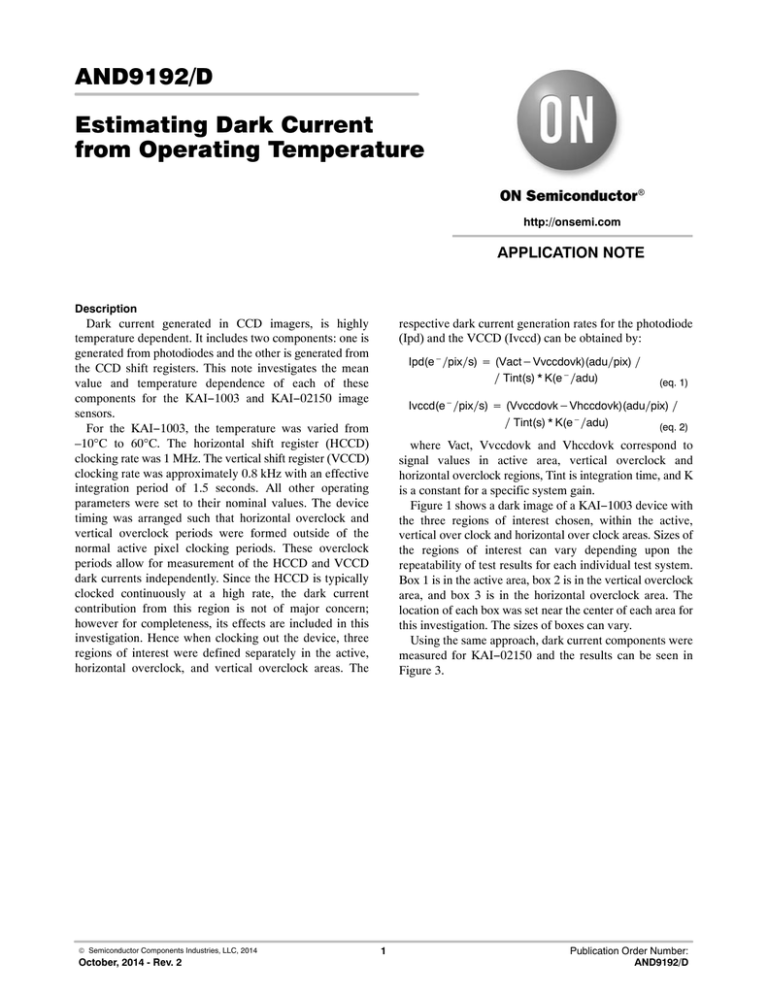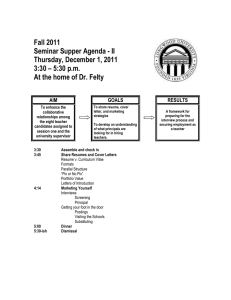Estimating Dark Current from Operating Temperature
advertisement

AND9192/D Estimating Dark Current from Operating Temperature http://onsemi.com APPLICATION NOTE Description respective dark current generation rates for the photodiode (Ipd) and the VCCD (Ivccd) can be obtained by: Dark current generated in CCD imagers, is highly temperature dependent. It includes two components: one is generated from photodiodes and the other is generated from the CCD shift registers. This note investigates the mean value and temperature dependence of each of these components for the KAI−1003 and KAI−02150 image sensors. For the KAI−1003, the temperature was varied from –10°C to 60°C. The horizontal shift register (HCCD) clocking rate was 1 MHz. The vertical shift register (VCCD) clocking rate was approximately 0.8 kHz with an effective integration period of 1.5 seconds. All other operating parameters were set to their nominal values. The device timing was arranged such that horizontal overclock and vertical overclock periods were formed outside of the normal active pixel clocking periods. These overclock periods allow for measurement of the HCCD and VCCD dark currents independently. Since the HCCD is typically clocked continuously at a high rate, the dark current contribution from this region is not of major concern; however for completeness, its effects are included in this investigation. Hence when clocking out the device, three regions of interest were defined separately in the active, horizontal overclock, and vertical overclock areas. The © Semiconductor Components Industries, LLC, 2014 October, 2014 - Rev. 2 Ipd(e *ńpixńs) + (Vact*Vvccdovk)(aduńpix) ń ń Tint(s) * K(e *ńadu) (eq. 1) Ivccd(e *ńpixńs) + (Vvccdovk*Vhccdovk)(aduńpix) ń ń Tint(s) * K(e *ńadu) (eq. 2) where Vact, Vvccdovk and Vhccdovk correspond to signal values in active area, vertical overclock and horizontal overclock regions, Tint is integration time, and K is a constant for a specific system gain. Figure 1 shows a dark image of a KAI−1003 device with the three regions of interest chosen, within the active, vertical over clock and horizontal over clock areas. Sizes of the regions of interest can vary depending upon the repeatability of test results for each individual test system. Box 1 is in the active area, box 2 is in the vertical overclock area, and box 3 is in the horizontal overclock area. The location of each box was set near the center of each area for this investigation. The sizes of boxes can vary. Using the same approach, dark current components were measured for KAI−02150 and the results can be seen in Figure 3. 1 Publication Order Number: AND9192/D AND9192/D Horizontal Transfer 1 3 Vertical Transfer 2 Figure 1. Image from KAI−1003 using both Horizontal and Vertical Overclocking Results temperature range around 0°C. The VCCD dark current increases faster than that of the photodiodes when temperature increases. At 60°C, the ratio of the VCCD dark current over the photodiode dark current is approximately 100X. At 30°C, the doubling rate for the VCCD is approximately 6°C where as for the photodiodes; the doubling rate is approximately 8°C. Figure 2 shows the results of the temperature dependence of dark current generation rates from the photodiodes and the VCCD registers. The dark current has been normalized to the pixel area and hence is expressed in electrons per pixel per second. On average, the VCCD has 10X the dark current contribution as that of the photodiodes in the low http://onsemi.com 2 AND9192/D KAI−1003M Dark Currents vs. Temperature Dark current generation rate (e/pix/s) 100000 10000 1000 Ivccd 100 Ipd 10 1 0.1 -10 −5 0 10 15 20 25 30 35 40 45 50 55 60 65 70 5 Temp (5C) Figure 2. Dark Current Temperature Dependence for KAI−1003 10000 1000 Dark Current (e/s) VCCD 100 Photodiode 10 1 1000/T (K) 2.90 T (C) 72 3.00 3.10 3.20 3.30 3.40 60 50 40 30 21 Figure 3. KAI−02150 Dark Current http://onsemi.com 3 AND9192/D For one output at pixel rate 1 MHz, the readout time is: The temperature dependence of dark currents generated from both the photodiodes and the vertical CCD registers is shown for the KAI−02150 device. For this diagram the temperature is shown using 1/T in order to show a more linear plot in the Log diagram. On the tip of the diagram 60, 50 and 40°C are indicated as reference. Tr = 1140 (pix/line) * 1036 (line/frame) * (sec/pix) / 106 = = 1.2 s The dark current from the photodiodes for each frame is: 10 * 1.2 = 12 e−/pix ESTIMATING DARK CURRENT SIGNAL LEVELS Dark currents generated from the photodiodes and vertical CCD registers under certain frame rates and temperature conditions can be estimated by the following equations: and that from the vertical CCD registers is: 550 * 1.2 = 660 e−/pix Dpd(e *ńpix) + Ipd(e *ńpixńs) * Tint(s) (eq. 3) Dvccd(e *ńpix) + Ivccd(e *ńpixńs) * Tr(s) (eq. 4) The total dark current for each frame captured at above condition is approximately 672 electrons of dark signal, with the primary component coming from the vertical CCD registers. Dtot(e *ńpix) + Dpd(e *ńpix) ) Dvccd(e *ńpix) (eq. 5) Example 3 In case of KAI−1003 at pixel rate 1 MHz/output, one output, −5°C, Tint = 5 minutes, camera frame size (horizontal x vertical) = 1024 x 1024 For one output at pixel rate 1 MHz, the readout time is: where Dpd, Dvccd, and Dtot represent the dark current (in electrons) from the photodiodes, vertical CCD registers and the total, respectively. Ipd and Ivccd are the dark current generation rates at certain temperature for photodiodes and vertical CCD registers, which can be obtained from the graphs in Figure 2. Tint is the photodiode integration period and Tr is the frame readout period. Sample calculations are shown below. Tr = 1.2 s (see Example 2) At −5°C, the dark current from the photodiodes is approximately 0.7 e−/pix/s and that from the vertical CCD registers is approximately 6 e−/pix/s. Since the integration time is 5 minutes for each frame, the dark current from the photodiodes is: Example 1 In case of KAI−1003 at pixel rate 20 MHz/output, two outputs, 25°C, Tint = Tr, camera frame size (horizontal x vertical) = 1024 x 1024. For two outputs at pixel rate 20 MHz, the readout time is: 0.7 * 5 * 60 = 210 e−/pix The dark current contribution from the vertical CCD registers is: Tr = 612 (pix/line) * 1036 (line/frame) * (sec/pix) / (20*106) = 31.7 ms 6 * 1.2 = 7.2 e−/pix (Refer to page 6 of the KAI−1003 specification). From Figure 2, at 25°C, dark current generated from the photodiodes is approximately 10 e−/pix/s. Therefore for each frame captured, dark current is: Therefore, the total dark current for each frame captured at above condition is approximately 217 electrons of dark signal, with primary component coming from the photodiodes. 10 * 0.0317 = 0.3 e−/pix Example 4 In case of KAI−02150 at pixel rate 40 MHz/output, two outputs, 40°C, Tint = 31 ms (Refer to page 31 of the KAI−02150 specification) From Figure 3 at 40°C, dark current generated from the photodiodes is approximately 9 e−/pix/s. Therefore for each frame captured, dark current is: Similarly, dark current generated from the vertical CCD registers at this temperature is approximately 550 e−/pix/s. For each frame, it contributes 550 * 0.0317 = 17.4 e−/pix In total then, there are approximately 18 electrons of dark current signal generated for each frame when a KAI−1003 device is operated at above condition. 9 * 0.031 = 0.33 e−/pix Similarly, dark current generated from the vertical CCD registers at this temperature is approximately 200 e−/pix/s. For each frame, it contributes Example 2 In case of KAI−1003 at pixel rate 1 MHz/output, one output, 25°C, Tint = Tr, camera frame size (horizontal x vertical) = 1024 x 1024 200 * 0.031 = 6.2 e−/pix http://onsemi.com 4 AND9192/D In total then, there are approximately 6.53 electrons of dark current signal generated for each frame when a KAI−02150 device is operated at above condition. From Figure 3 at 60°C, dark current generated from the photodiodes is approximately 30 e−/pix/s. Therefore for each frame captured, dark current is: Example 5 30 * 0.0155 = 0.46 e−/pix In case of KAI−02150 at pixel rate 40 MHz/output, two outputs, 60°C, Tint = 31 ms (Refer to page 31 of the KAI−02150 specification) From Figure 3 at 60°C, dark current generated from the photodiodes is approximately 30 e−/pix/s. Therefore for each frame captured, dark current is: Similarly, dark current generated from the vertical CCD registers at this temperature is approximately 1050 e−/pix/s. For each frame, it contributes 1050 * 0.0155 = 16.3 e−/pix In total then, there are approximately 16.7 electrons of dark current signal generated for each frame when a KAI−02150 device is operated at above condition. 30 * 0.031 = 0.93 e−/pix Similarly, dark current generated from the vertical CCD registers at this temperature is approximately 1050 e−/pix/s. For each frame, it contributes SUMMARY The dark current for the KAI−1003 and KAI−02150 has been characterized as a function of temperature. The two components of the dark current have been identified wherein the VCCD component has been shown to have a higher generation rate, by nearly a factor of 10 at temperature around 0°C and a factor of 100 at temperature around 60°C. However, depending upon the application and integration period, either component may dominate. A simple calculation, based on the examples above, ensures proper treatment of dark current for a given application. 1050 * 0.031 = 32.55 e−/pix In total then, there are approximately 33.48 electrons of dark current signal generated for each frame when a KAI−02150 device is operated at above condition. Example 6 In case of KAI−02150 at pixel rate 40 MHz/output, four outputs, 60°C, Tint = 15.5 ms (Refer to page 31 of the KAI−02150 specification) ON Semiconductor and the are registered trademarks of Semiconductor Components Industries, LLC (SCILLC) or its subsidiaries in the United States and/or other countries. SCILLC owns the rights to a number of patents, trademarks, copyrights, trade secrets, and other intellectual property. A listing of SCILLC’s product/patent coverage may be accessed at www.onsemi.com/site/pdf/Patent−Marking.pdf. SCILLC reserves the right to make changes without further notice to any products herein. SCILLC makes no warranty, representation or guarantee regarding the suitability of its products for any particular purpose, nor does SCILLC assume any liability arising out of the application or use of any product or circuit, and specifically disclaims any and all liability, including without limitation special, consequential or incidental damages. “Typical” parameters which may be provided in SCILLC data sheets and/or specifications can and do vary in different applications and actual performance may vary over time. All operating parameters, including “Typicals” must be validated for each customer application by customer’s technical experts. SCILLC does not convey any license under its patent rights nor the rights of others. SCILLC products are not designed, intended, or authorized for use as components in systems intended for surgical implant into the body, or other applications intended to support or sustain life, or for any other application in which the failure of the SCILLC product could create a situation where personal injury or death may occur. Should Buyer purchase or use SCILLC products for any such unintended or unauthorized application, Buyer shall indemnify and hold SCILLC and its officers, employees, subsidiaries, affiliates, and distributors harmless against all claims, costs, damages, and expenses, and reasonable attorney fees arising out of, directly or indirectly, any claim of personal injury or death associated with such unintended or unauthorized use, even if such claim alleges that SCILLC was negligent regarding the design or manufacture of the part. SCILLC is an Equal Opportunity/Affirmative Action Employer. This literature is subject to all applicable copyright laws and is not for resale in any manner. PUBLICATION ORDERING INFORMATION LITERATURE FULFILLMENT: Literature Distribution Center for ON Semiconductor P.O. Box 5163, Denver, Colorado 80217 USA Phone: 303−675−2175 or 800−344−3860 Toll Free USA/Canada Fax: 303−675−2176 or 800−344−3867 Toll Free USA/Canada Email: orderlit@onsemi.com N. American Technical Support: 800−282−9855 Toll Free USA/Canada Europe, Middle East and Africa Technical Support: Phone: 421 33 790 2910 Japan Customer Focus Center Phone: 81−3−5817−1050 http://onsemi.com 5 ON Semiconductor Website: www.onsemi.com Order Literature: http://www.onsemi.com/orderlit For additional information, please contact your local Sales Representative AND9192/D

